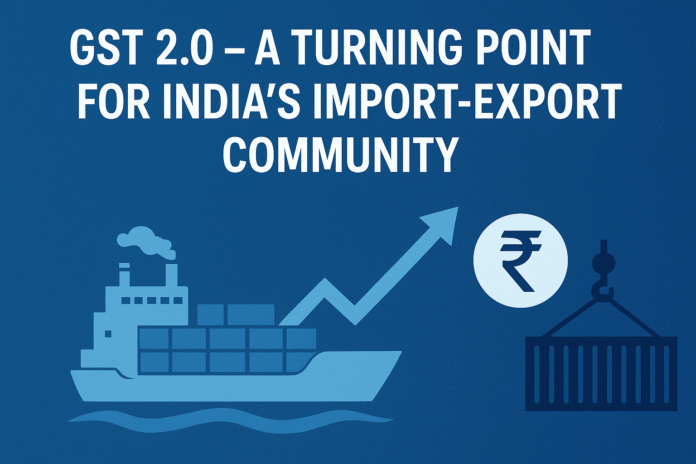For those of us in the import-export business, taxation isn’t just a number on paper — it decides our cash flow, competitiveness, and ultimately, our ability to grow globally. The launch of GST Reform 2.0 on 22 September 2025 is more than just a rate change; it’s a shift in how India wants to position itself as a trade hub.
Let’s break this down in plain language — what has changed, why it matters, and how you, as a global trader, can benefit.
What GST 2.0 Means for Trade
GST was introduced in 2017 to simplify India’s tax system by creating one nation, one tax. But for importers and exporters, compliance remained complex — multiple slabs, classification disputes, input tax credit delays, and working capital getting locked up at ports.
GST 2.0 fixes many of these pain points:
- Fewer tax slabs (now 0%, 5%, 18%, and 40%) mean fewer classification disputes at Customs.
- Lower rates on essentials, raw materials, and key capital goods reduce import costs.
- Clearer ITC (Input Tax Credit) workflows aim to free up working capital faster, especially for exporters who rely on zero-rated supplies and refunds.
- Stricter compliance on luxury/sin goods ensures a level playing field for ethical trade.
How This Impacts Importers
- Lower Landing Costs
If you import machinery, electronic components, or consumer goods, the drop from 28% to 18% GST can significantly reduce landed costs. This makes products more price-competitive in India and can boost demand.
- Better Cash Flow
Delayed GST refunds have been a headache for many importers. GST 2.0 promises faster ITC processing and automated reconciliation, meaning your money isn’t stuck in the system as long.
- Simplified Classification
Misclassification at ports often led to disputes and demurrage. With fewer slabs, the risk of being put in the wrong tax bracket drops, reducing penalties and clearance delays.
How This Impacts Exporters
- Faster Refunds, Quicker Working Capital Turnaround
Exporters work on thin margins and need liquidity to fulfill orders. GST 2.0’s automation of refund processing (with fewer manual checks) can speed up GST reimbursements, allowing exporters to reinvest faster.
- Competitive Pricing in Global Markets
With cheaper inputs (thanks to reduced GST on raw materials), exporters can offer better pricing abroad, making Indian goods more competitive.
- Encouragement for MSME Exporters
Small-scale exporters often struggled with GST compliance costs. Simplification and slab reduction reduce their administrative burden, letting them focus on scaling global sales.
Real-World Example
Take a freight forwarder handling auto parts imports:
- Earlier, GST at 28% plus classification confusion increased landed costs and clearance times.
- Under GST 2.0, the rate is 18%, classification is clearer, and ITC comes back faster — reducing working capital strain.
- This allows the importer to stock more inventory, fulfill orders on time, and negotiate better freight rates due to predictable volumes.
Strategic Takeaways for Trade Professionals
- Audit Your SKUs & HS Codes: Re-check classification under new slabs to maximize savings.
- Update ERP/Customs Documentation: Ensure invoicing and EDI filings reflect new GST rates to avoid compliance issues.
- Pass Benefits to Buyers: Whether domestic distributors or overseas buyers, transparent pricing can help build trust.
- Leverage Lower Costs to Expand: Use freed-up capital to explore new markets or diversify product lines.
Big Picture: India’s Trade Competitiveness
GST 2.0 isn’t just a tax cut — it’s a statement. India wants to simplify trade, cut red tape, and make its exporters more globally competitive. Lowering indirect tax costs while improving refund efficiency could help India climb global ease-of-doing-business rankings and attract foreign investments in manufacturing and logistics.
Conclusion
For importers and exporters, GST 2.0 is a call to action — review your tax structures, streamline compliance, and use the cost savings to grow. In global trade, every percentage saved is a competitive advantage. This reform gives you a chance to turn compliance into a business edge.




